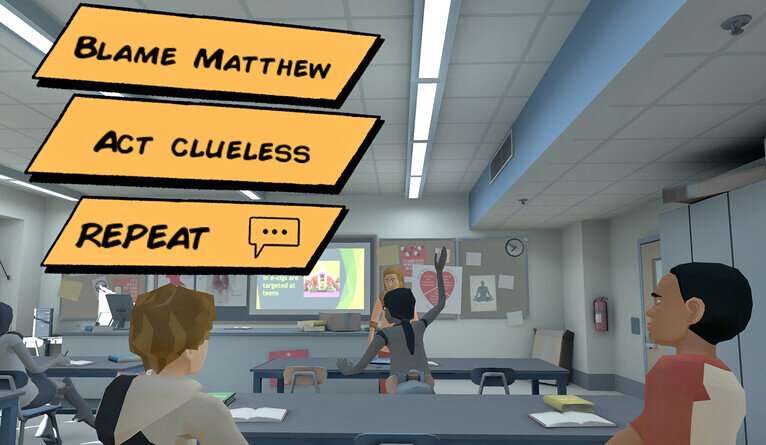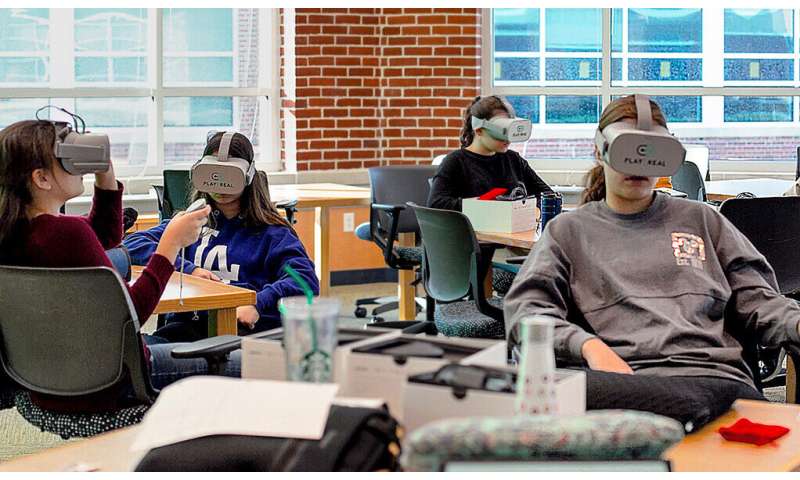
For years, Dr. Asher Marks, an assistant professor of pediatrics at Yale School of Medicine and director of the Adolescent and Young Adult (AYA) Cancer Program at Yale New Haven Hospital, has urged his young patients to attend support groups. Meeting with other patients is well known to improve survival chances and alleviate depression.
But often he’d find that the in-person therapy sessions hosted by AYA were empty.
So in 2019, Marks tried another approach: a virtual reality support group. Patients were given headsets and asked to join an immersive chat room with other patients and a social worker, during which they were asked to discuss their condition in a comfortable setting.
In an ongoing trial, Marks, who is also director of pediatric neuro-oncology at Yale, has found that patients participating in the VR sessions experienced reduced levels of anxiety and depression.
Across Yale, other researchers are embracing Extended Reality (XR) technologies (including virtual, extended, and mixed reality). Particularly for those working with children and adolescents, these technologies offer a means to connect with patients in a space where they often feel most comfortable.
Kimberly Hieftje, a research scientist at the School of Medicine and director of the play4REAL XR Lab, uses XR technology, including virtual and augmented reality tools, to help teens and young adults to reduce risky behaviors such as vaping or alcohol use.
Other Yale researchers are using the technology to study navigation in patients with epilepsy using driving simulations and to help medical students understand spatial relationships in the brain.
And evidence is mounting of its benefits in treatment and training.
For Marks, the technology offers a safe alternative to young patients who might otherwise have difficulty attending group sessions or who are uncomfortable talking in a public session. These were the kinds of factors that limited participation in the in-person group sessions.
“It was a combination of things,” he said. “They didn’t want to come back to the hospital once their chemo was done. They weren’t feeling well. They didn’t want to be seen.”

During the clinical trial, which involved young adult patients in one of three virtual groups to look at outcomes for anxiety, depression, and resilience, participants were able to join the conversation in the guise of avatars, much like they would in other online platforms and video games. (Currently these avatars are very human in likeness, he says, but they are moving into more imaginary/fantastical directions.)
The app was developed in collaboration with Foretell Reality.
“One of the big priorities was that the avatars be able to express body language as well as the patients can,” said Marks. “We’ve got that down pretty well. You can actually see hand movements, you can see them leaning into the conversation, leaning out from the conversation, folding their hands, things like that.”
According to initial results, the virtual therapy sessions reduced levels of anxiety and depression. Now, Marks says, the researchers are planning to expand these sessions to other clinics throughout the hospital.
At the play4REAL XR Lab, Hieftje has seen similarly positive outcomes. Her research has focused on how video games can be used as tools to redirect teens to more positive health behaviors by having them walk through various virtual scenarios, interact with characters, and make choices in real time using voice recognition software.
For the anti-vaping virtual reality game, Invite Only VR, Hieftje and other researchers followed 25 Connecticut middle school students for six months to see how playing the game would impact various behavioral indicators toward vaping, including harm and social perceptions, e-cigarette and nicotine addiction knowledge, and their likelihood to vape in the future. The results will be published soon, but Hieftje says they see benefits in the development of “soft skills” that can then translate into real-world practice.
The VR approach, she said, also has real advantages as a learning tool. The immersion required by VR, and the use of the headsets, truly makes teens a captive audience. And they are able to practice behaviors in a safe environment based on their own judgment.
“Instead of just clicking through different choices in a web-based game or an app, kids are actually using their voices to respond to peers,” she said. “And those characters in the games are making eye contact with them and responding back. There are a lot of opportunities to practice and get things wrong, see what the outcomes are and then try something different.”
Between its therapeutic value and its value for educating clinicians, virtual reality is likely to take on a larger role at the Yale School of Medicine. In a new collaborative project involving both Marks and Hieftje, Yale undergraduates are creating three-dimensional virtual reality brains from MRI scans that they can then explore, a sort of “Magic School Bus” for medical students.
In the past, Marks has worked with the Center for Collaborative Arts and Media—a fertile space on campus for exploring collaborative projects that has a VR suite and production studio. But the researchers envision a center for VR research specific to Yale Medical School.
Source: Read Full Article